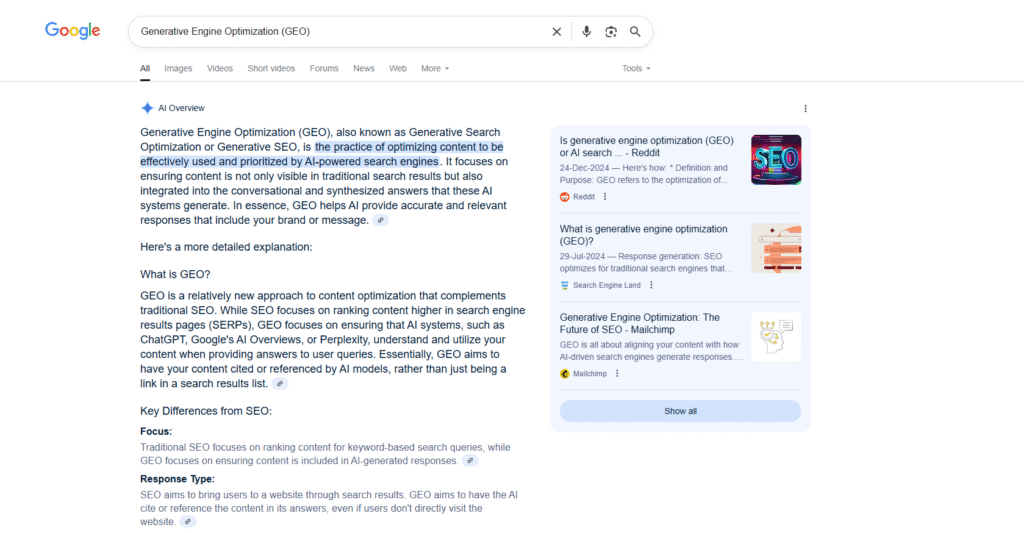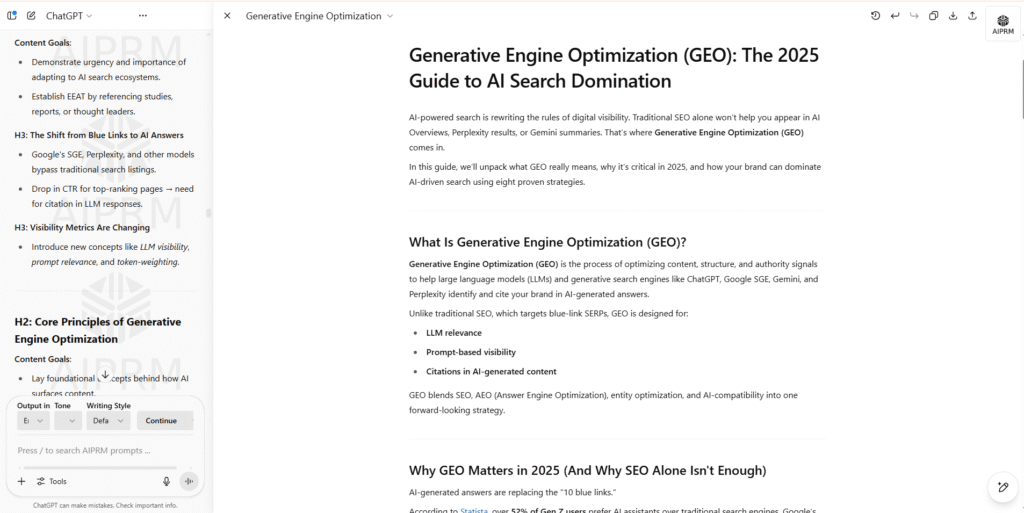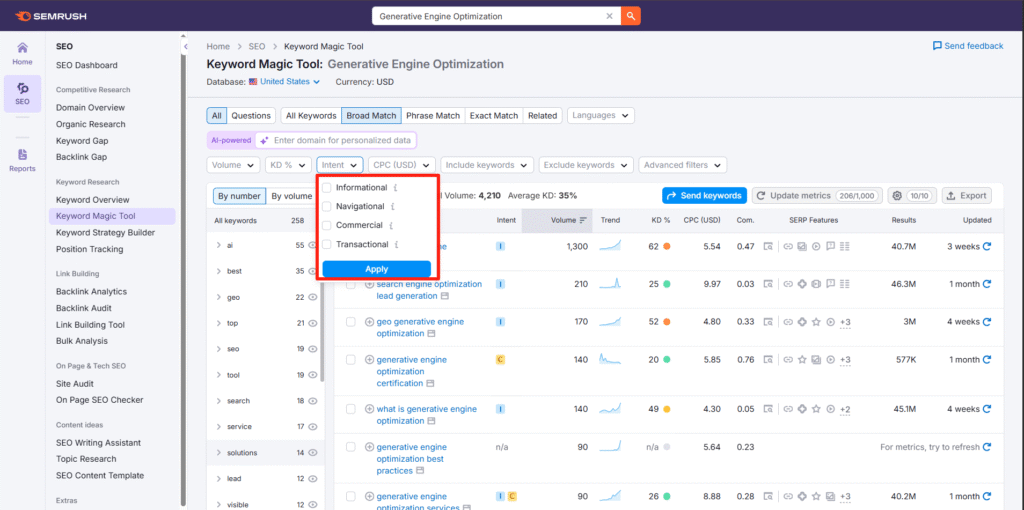AI-powered search is rewriting the rules of digital visibility. Traditional SEO alone won’t help you appear in AI Overviews, Perplexity results, or Gemini summaries. That’s where Generative Engine Optimization (GEO) comes in.
In this guide, we’ll unpack what GEO really means, why it’s critical in 2025, and how your brand can dominate AI-driven search using eight proven strategies.
What Is Generative Engine Optimization (GEO)?

Generative Engine Optimization (GEO) is the process of optimizing content, structure, and authority signals to help large language models (LLMs) and generative search engines like ChatGPT, Google SGE, Gemini, and Perplexity identify and cite your brand in AI-generated answers.
Unlike traditional SEO, which targets blue-link SERPs, GEO is designed for:
LLM relevance
Prompt-based visibility
Citations in AI-generated content
GEO blends SEO, AEO (Answer Engine Optimization), entity optimization, and AI-compatibility into one forward-looking strategy.
Why GEO Matters in 2025 (And Why SEO Alone Isn't Enough)

AI-generated answers are replacing the “10 blue links.”
According to Statista, over 52% of Gen Z users prefer AI assistants over traditional search engines. Google’s AI Overviews are already rolling out across billions of queries.
What does that mean for your brand?
Less organic traffic from SERPs.
More importance on being the source of AI answers.
Higher value on entity-driven, fact-rich, and trustworthy content.
If you’re not optimizing for GEO, you risk becoming invisible in the AI-driven search future.
1. Identify & Align With Generative Search Intent

What to Do:
Understand how people search when using AI tools. Their queries are longer, more contextual, and resemble conversations.
How to Implement:
Use tools like AlsoAsked, Answer the Public, and ChatGPT to extract conversational intent.
Group your topics by “how,” “why,” and “what” style prompts.
Structure your content to directly answer these with simple, scannable blocks.
Example: Instead of “Best SEO tools,” try “What are the best AI-powered SEO tools for small businesses in 2025?”
2. Optimize for Entity Recognition (GEO Core Principle)
What to Do:
AI models use entity-based comprehension to recognize brands, products, and people.
How to Implement:
Use Google’s NLP API or OnPage.ai Entity Explorer to evaluate your content.
Strengthen your brand’s presence across structured data, social media bios, LinkedIn, and schema.
Mention relevant supporting entities: tools, industries, and connected topics.
Pro Tip: Use schema markup for Organization, Person, and FAQ to reinforce your content’s structure.
Format Content for AI Overviews & Featured Snippets
What to Do:
Create content blocks that AI can lift easily.
How to Implement:
Start each section with a clear question.
Provide a concise answer in 40–60 words.
Use lists, tables, or bullet formats.
Follow with a deep dive for human readers.
Example Snippet Format: Q: What is GEO in SEO? Generative Engine Optimization (GEO) is the process of optimizing content to be cited in AI-generated search answers by LLMs like ChatGPT and Gemini.
4. Publish Authoritative, Evidence-Based Content
What to Do:
GEO success depends on trust. AI prefers factual, non-speculative, well-sourced content.
How to Implement:
Back up claims with statistics (e.g., HubSpot, Statista).
Cite trusted experts like Google, Shopify, Neil Patel.
Use first-hand experience or client success stories.
Example: “After implementing structured FAQs and llms.txt, we saw a 37% increase in AI mentions from Perplexity.”
5. Add Structured Data & Use llms.txt Files
What to Do:
AI engines benefit from structured guidance on your content and its usage.
How to Implement:
Add FAQ, Article, Product, and How-to schema.
Create an
llms.txtfile specifying how AI can use your content (like robots.txt for LLMs).
Helpful Resource: llms.txt Github project
6. Build High-Authority Backlinks & Brand Mentions
What to Do:
Backlinks help LLMs validate authority and trust.
How to Implement:
Target links from high-authority, AI-visible sources.
Focus on branded anchor text.
Use digital PR, guest posting, and press mentions.
Tip: Create stat-based content others want to cite.
7. Use Conversational, Natural Language Everywhere
What to Do:
Write in a human, natural tone—AI prefers it.
How to Implement:
Avoid robotic keyword stuffing.
Write like you’re talking to a friend who’s asking a question.
Use contractions, short sentences, and plain language.
Example: “Let’s break it down… GEO is basically how you get your content in front of AI tools.”
8. Monitor LLM Visibility with GEO Tools
What to Do:
You can’t improve what you don’t measure.
How to Implement:
Use tools like Alli AI, EngineRank, Nozzle, or BrightEdge.
Track citations in Gemini, Perplexity, or AI Overviews.
Adjust your GEO strategy based on performance.
Bonus Tip: Repurpose Content for AI-Friendly Platforms
Your content shouldn’t just live on blogs.
Convert snippets into LinkedIn carousels.
Turn lists into video explainers for YouTube.
Feed FAQs into ChatGPT, Claude, and Perplexity.
Why? It’s omni-channel SEO for the AI age.
Conclusion: Start GEO Now or Be Left Behind
GEO isn’t a futuristic idea. It’s here now.
By following these 8 strategies, your brand can:
Stay ahead of competitors
Be cited by AI systems
Increase organic traffic via generative engines
Start implementing today. AI search isn’t replacing SEO—it’s evolving it.
Frequently Asked Questions (FAQs)
GEO is the process of making your content visible and cite-worthy in AI-generated search results, especially from tools like Gemini, Perplexity, or ChatGPT.
SEO focuses on traditional search rankings. GEO focuses on visibility within AI-generated responses and large language model citations.
Use tools like Perplexity, EngineRank, or Alli AI to monitor mentions, citations, or snippets in AI search responses.